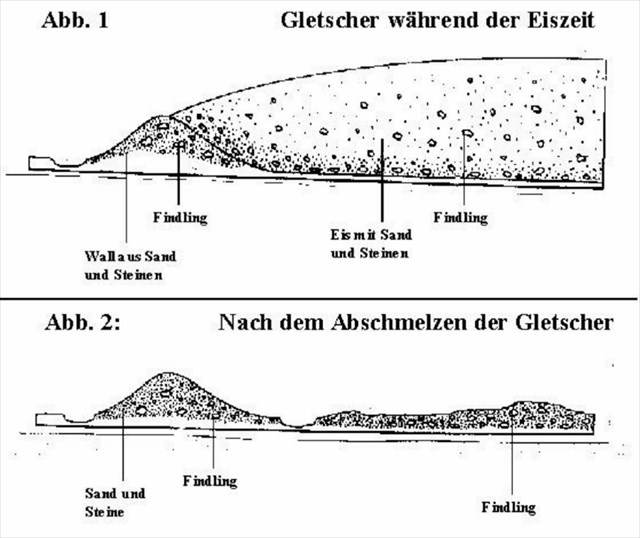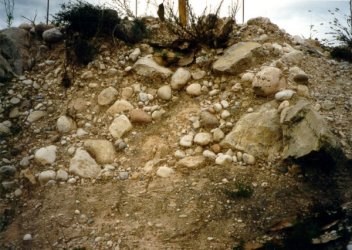English version 
Remark: This translation was made with a help from google translator. We know that some formulations in the text below may be wrong, sorry for that !
But we look forward everyone may help us to make the text better !
end moraines - Remnants of the ice age
A mountain of rubble - The moraine
Or
The mountain Peak of Maasholm - A hike in Schleswig-Holstein East
Introduction:
With this Earthcache we want to invite you to a very special experience:
A hike in Schleswig-Holstein!
This is possible only in the east of Schleswig-Holstein. Why?
To do this we must delve deeper into the landscape and the history of Schleswig-Holstein.
Schleswig-Holstein can be roughly divided into three different landscapes, all of which run north to south.
In the West, the North Sea towards the march as a largely post-glacial and marine incurred metropolitan area and the Wadden Sea.
In the West, the North Sea towards the march as a largely post-glacial and marine incurred metropolitan area and the Wadden Sea.
In the middle then the Geest, an area with predominantly sandy soils. To march out area there is moraine of the Saale-Warta moraine.
In the east, here on site at the Earth cache, we find the so-called hill country.
It is the youngest of the three landforms created by several very closely spaced ice border of the Weichselian ice age, which has given its hilly landscape character of end-moräne forms. The light coming from the northeast ice pushed loose material before them and stored it off.
But now to the EarthCache (our mountain-hike)
Your best start is by the nature center (signposted and easy to find, you drive past it if you ride after red herring). HIGHLY RECOMMENDED!
Or you start at one of the many parking spaces directly in Massholm.
The goal of the cache coordinates is the head of a glacial End-moraine deposition.

Look the picture above : maybe so or similar the landscape here was like the picture in that time
Under moraines we understood all the material that has been transported by a glacier. This refers to the debris deposits that have been moved or piled by the glaciers as they move.
Basically, two types of moraines can be distinguished:
Wandering moraines and deposited moraines.
Wandering moraines were moved by the ice.
These include the Upper moraines, Inner moraines, Under moraines, lateral moraines, medial moraines and glacial.
Upper moraines derived from the material that has fallen from the cliffs of the glacier has been deposited during the melting of the glacier.
Inner moraines include all the material that was transported inside the glacier.
Under moraines form at the glacier base. The material of the Under moraine is very strong ground and crushed by the friction with the ground.
Lateral moraines form along the edges of the glacier tongue. Your material is derived on the one hand by the side of bedrock, for the most part but from former Under moraines that were performed on the sides of the glacier.
Medial moraines are formed from the two glaciers, if this flow together and unite.
Bedload is all material that has been moved from the ice.
Deposited moraines were not moved on.
These include the ground moraines and end moraines the.
Moraines consist of the material of the lower and Inner moraines.
Moraines formed as debris accumulation on the glacier end, when the glacier front is not moving for a long time. On them you can very well see the largest expansion of the glacier.

See the picture above: The wall of sand and stones is the end moraine
After the time of origin are distinguished young moraines (Weichselian, Würm) of old moraines (from the previous ice ages).
The term includes all moraine rubble that were carried and deposited by the ice. Moraines consist of material of different grain size from clay to sand to large boulders. But the material is mixed and has no sorting by size in the rule.


See the pictures above: examples for deposition material.
To the cache coordinates you are on the top of a glacial End moraine deposition.
From here you have a beautiful view over the countryside and the Schlei.
Look around a little and answered the following questions:
1 Is the original material of the moraine still visible?
2 What form of material was deposited here by the glacier?
3 Find out which of these glacial deposits derived.
4 Imagine you have stood on this site at that time:
Describes in own words how you envision the environment at the time - what would
you see, where would you stand on, for example?
After the response to our profile, or directly to teamchritho@go4more.de you can log immediately - if something is wrong we will contact you.
As usual with EC's we also look forward to great photos (but this is no loging condition!)
Sources:
Wikipedia
satgeo.zum.de
cms.fu-berlin.de
information panel
gidimap.giub.uni-bonn.de/
heimatverein.he-webpack.de/
www.Nordpaul.de